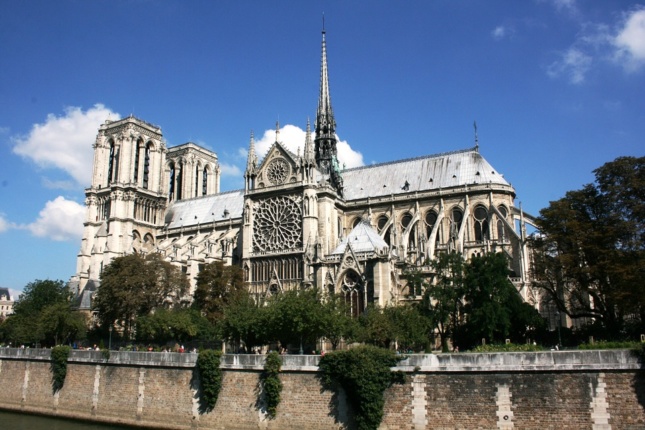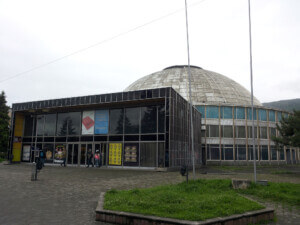The world watched in total shock on Monday evening as a devastating fire ravaged parts of the Notre Dame Cathedral in Paris. For a moment it looked like the French landmark might be lost completely, but firefighters acted quickly to save the 850-year-old Gothic church. Though a battered version of its former self, Notre Dame still stands today largely because its 226-foot twin bell towers were kept from ruin.
“The bell towers are actually like bookends,” noted Thomas Leslie, a Gothic structures specialist and the Morrill Professor of Architecture at Iowa State University. “They keep the last vaults from toppling over or spreading out. A lot of people know that flying buttresses are supporting the vaults in one direction from the exterior, but those vaults also want to collapse along the nave. If stone bell towers, which have wooden structures inside them, had ignited and had collapsed, the whole cathedral could have come down in an instant.”
In other words, at some point the Paris Fire Brigade made the decision to stop focusing on the expansive roof fire, and spend its resources on the stone bell towers, both of which date back to the mid-13th century. “The roof was a lost cause and they knew it wasn’t going to lead to the collapse of the building’s skeleton,” asserted Leslie.

When the fire began around 6:50 p.m. on Monday, panic spread throughout the world about the Notre Dame’s potential downfall. A roof fire, by most standards, is catastrophic. But what much of the media didn’t realize at first, Leslie argued, was that the wooden roof was detached from the structure itself and couldn’t trigger the building’s total collapse. Enough heat, however, could melt the masonry over the nave—the stonework on the structure was already under close watch.
For the past few years, Notre Dame has been undergoing an extensive, $6.8 million restoration. A piece of medieval construction, it’s been renovated and added onto several times in its history. The 315-foot-tall oak spire that fell in the fire was designed by French architect Eugène Emmanuel Viollet-le-Duc and installed in 1860 after the French Revolution and the elements had damaged the structure. Luckily, the 16 copper statues of the 12 apostles and four evangelists that sat at the spire’s base were removed for cleaning just last week and thus spared from the fire.
Along with the stone bell towers, the famed trio of round stained-glass windows survived the fire, including the famous South Rose window, which was donated by King St. Louis in 1260. The deputy mayor of Paris said Notre Dame’s 8,000-pipe Great Organ also sustained the event though it did suffer repairable damages. Several news outlets have reported the church’s irreplaceable art and artifacts were rescued and transferred to the Louvre Museum for safe keeping.
While these elements were saved, there’s a gaping hole left now in the nave less than 48 hours after the fire, exposing the interior of the cathedral. For Leslie, it’s the water damage done by the fire squad that’s even more concerning. “When you walk into a cathedral, what you see on the inside is the stone vaulting, there for structural and spatial reasons,” he said. “The timber roof above it essentially for weatherproofing. It keeps rain, snow, and ice off the limestone vaults. I noticed through images that water had pretty clearly penetrated the mortar joints in the surviving vaults. Limestone and lime mortar are both vulnerable to fire in the sense that they don’t burn, they turn into powder.”
Drone footage shows aftermath of #NotreDame fire damage from above. /via @ABC pic.twitter.com/aQ7XswE2Y4
— Yannis Koutsomitis (@YanniKouts) April 17, 2019
Securing the existing stonework within Notre Dame and protecting it from weather-damage in the near future are undoubtedly top of mind for the temporary restoration effort moving forward. For the long term, President Emmanuel Macron has promised a rebuild and people have already pledged over $900 million towards the planned reconstruction. Even an international competition to redesign the spire ahead of the 2024 Summer Olympics in Paris has already been launched.
Lisa Ackerman, interim CEO for the New York–based World Monument Fund, noted the energy of the moment. “The good thing about all this is that we live in a world where you find out about tragedies instantly and we’ve found both the outpouring of financial support for Notre Dame to be tremendous, as well as the outpouring of assistance from experts who can help rebuild.”
For example, the late art historian Andrew Tallon from Vassar College had scanned the entire cathedral with an accuracy within five millimeters. His detailed work is laid out in a stunning 3D laser map of Notre Dame, a piece of pivotal documentation that will likely be used in the restoration efforts. Even the popular video game Assassin’s Creed Unity, which is set in Paris, could be helpful. It’s publisher, Ubisoft, has offered expertise.
Collecting global documentation of Notre Dame will help in the upcoming work to stabilize the building for centuries to come. Integrating fire-safe products in the reconstruction, said Ackerman, will help ensure a catastrophic disaster like this doesn’t happen again.
“Preservation is always an act of negotiating the past with the present and the visual aesthetic qualities of the structure with new knowledge we have about materials,” she said. “The greatest danger to a historic building is when people think its issues are permanently resolved. Hopefully this was a reminder that many of the sites we take for granted actually have needs and must be continually repaired and investigated for their own wellbeing. If we defer maintenance, we endanger buildings in ways that are clearly unimaginable.”











